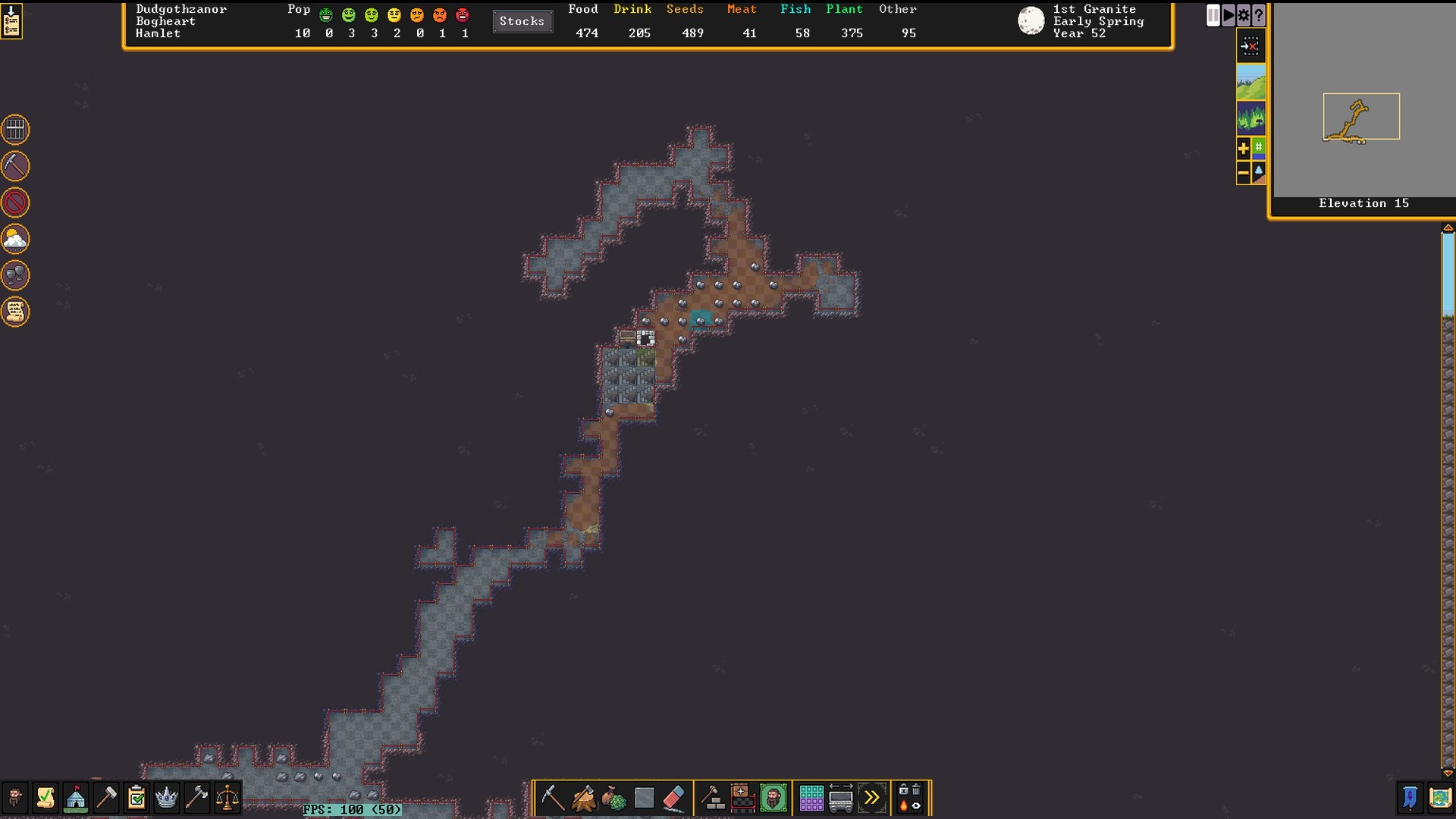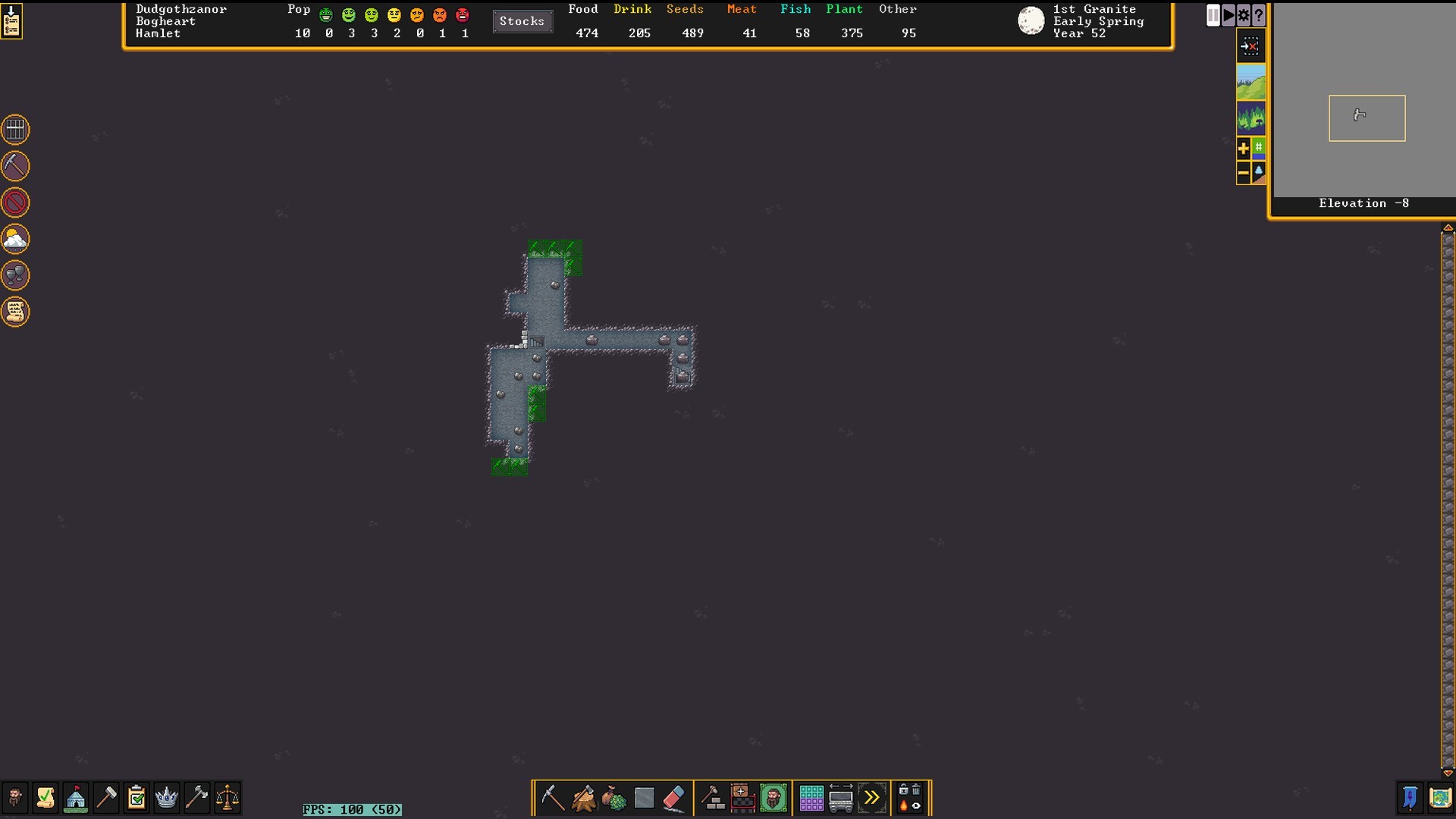I'm in a Dwarf Fortress succession game, where we each play a fort for 2 years and then pass of the save to the next person. It was my turn first, and I embarked into the middle of the perilous wild swamp, days of travel away from anything else. There was no iron on the map, which made things difficult, as expected, but the map did say there was tin, which could be used for bronze as a substitute. With the information about the embark out of the way, here are the screenshots I took at the end:

The entrance hall. Already not looking great, what with the skeleton just sitting there. There is a giant hamster there set to be trained though so it's not all bad.

The living area, with a tavern, dining hall, well, space for a future hospital, and 24 bedrooms, though I only ever got 18 dwarves because no migrants arrived after the first 2 waves, excluding some visiting monster hunters who became permanent residents.

The main crafting floor, made of mostly square tiles. There's a stairway up to clay and sand gathering areas.

The underground farming area, which I didn't really need because of all the fruit trees but I decided to make one anyway

The underground farm was built into a light aquifer, and I didn't know at the time that aquifers leak from the ceiling as well as the walls. I spent way too long digging out the ceiling, replacing it with wood, and sealing it off instead of just moving it somewhere else.

I tried to bring ore up to the crafting floor with minecarts but it didn't really work, the dwarves just wouldn't put things in the carts

The first cavern layer, with a carpenter workshop down there that I was using in my plans to seal off the entire caverns and make them safe.

I could not find the cassiterite I was planning on making bronze for weapons from, so I was very late in getting dwarves armed and armored and only had 2 soldiers when the first rodent men attacked. 3 dwarves died, including Asmel Vigorgolds, a hammerdwarf who took down like 6 of them in a martial trance before collapsing from overexertion. These are the abandoned catacombs, built in a mined out ore vein, where I planned to bury them.

A second and third wave of rodent men came one after another and I was not ready. I had to seal off the caverns, unable to save the dwarves who were still down there after I broke the stairs. This is where that left 2 of them stranded under the first caverns, and I dug an escape tunnel

The new catacombs, with the space at the top for tombs and the space at the bottom for memorializing those who died to the rodent men in places where I couldn't recover their corpses. There is a special alcove at the bottom for Asmel, filled with statues of his life and defense of the fort.
And that's all of it. If you want to look at it in more detail, here's a link to the save file.

The entrance hall. Already not looking great, what with the skeleton just sitting there. There is a giant hamster there set to be trained though so it's not all bad.

The living area, with a tavern, dining hall, well, space for a future hospital, and 24 bedrooms, though I only ever got 18 dwarves because no migrants arrived after the first 2 waves, excluding some visiting monster hunters who became permanent residents.

The main crafting floor, made of mostly square tiles. There's a stairway up to clay and sand gathering areas.

The underground farming area, which I didn't really need because of all the fruit trees but I decided to make one anyway

The underground farm was built into a light aquifer, and I didn't know at the time that aquifers leak from the ceiling as well as the walls. I spent way too long digging out the ceiling, replacing it with wood, and sealing it off instead of just moving it somewhere else.

I tried to bring ore up to the crafting floor with minecarts but it didn't really work, the dwarves just wouldn't put things in the carts

The first cavern layer, with a carpenter workshop down there that I was using in my plans to seal off the entire caverns and make them safe.

I could not find the cassiterite I was planning on making bronze for weapons from, so I was very late in getting dwarves armed and armored and only had 2 soldiers when the first rodent men attacked. 3 dwarves died, including Asmel Vigorgolds, a hammerdwarf who took down like 6 of them in a martial trance before collapsing from overexertion. These are the abandoned catacombs, built in a mined out ore vein, where I planned to bury them.

A second and third wave of rodent men came one after another and I was not ready. I had to seal off the caverns, unable to save the dwarves who were still down there after I broke the stairs. This is where that left 2 of them stranded under the first caverns, and I dug an escape tunnel

The new catacombs, with the space at the top for tombs and the space at the bottom for memorializing those who died to the rodent men in places where I couldn't recover their corpses. There is a special alcove at the bottom for Asmel, filled with statues of his life and defense of the fort.
And that's all of it. If you want to look at it in more detail, here's a link to the save file.